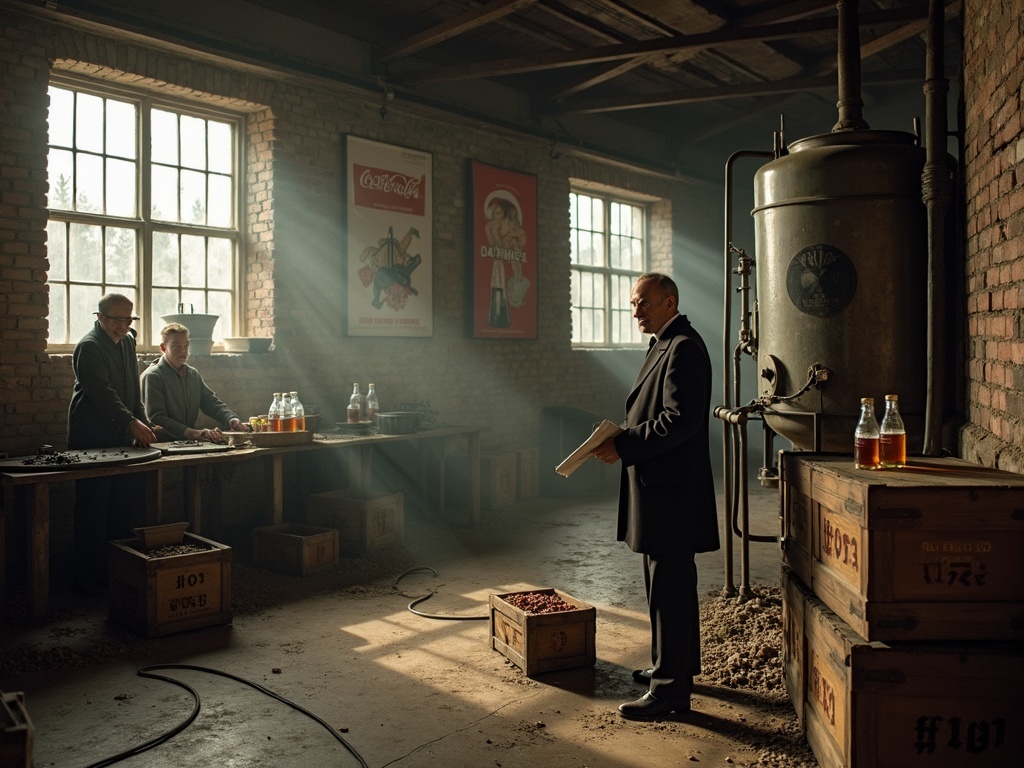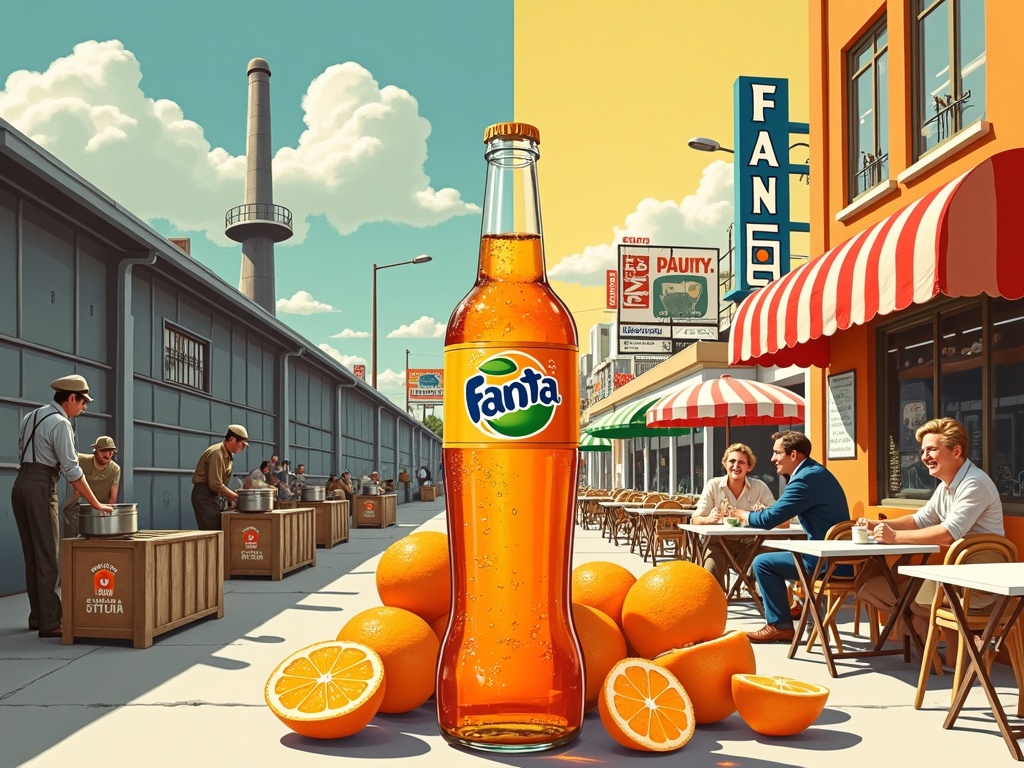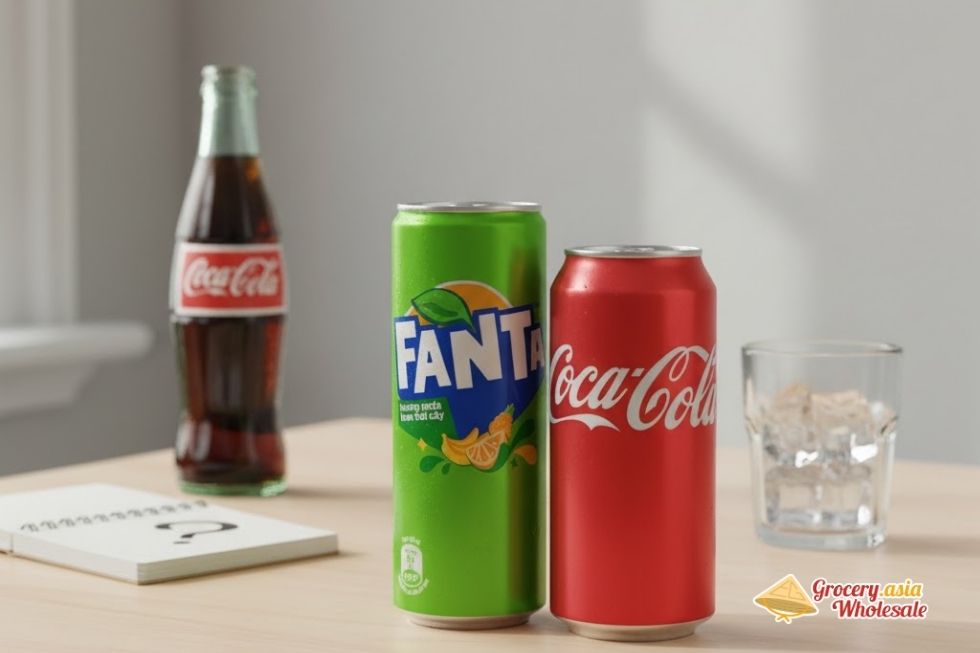No products in the cart.
Beverages News, Fanta Carbonated Soft Drinks, Soft Drinks
The Truth Behind: Is Fanta A Coke Product
Fanta stands as a definitive Coca-Cola product, owned and operated by The Coca-Cola Company since its creation in 1940 during World War II in Nazi Germany. Despite its unusual wartime origins as a substitute beverage made from food industry scraps, Fanta has evolved into one of Coca-Cola’s most successful global brands, generating over $1 billion in annual retail sales across more than 190 countries.
Table of Contents
Key Takeaways
- Fanta is The Coca-Cola Company’s second oldest brand, created in 1940, making it a core component of their global beverage portfolio alongside Coca-Cola, Sprite, and Schweppes.
- The brand originated in Nazi Germany during World War II when trade embargoes cut off Coca-Cola syrup imports, leading to the creation of a substitute drink made from whey, apple pomace, and fruit scraps.
- Coca-Cola’s extensive global distribution network gives Fanta a significant competitive advantage over rival orange soda brands like Sunkist and Mirinda, enabling market penetration that smaller companies cannot match.
- Fanta offers over 200 unique flavors worldwide, with regional variations adapted for local taste preferences while maintaining consistent quality standards through Coca-Cola’s production infrastructure.
- The brand generates over $1 billion in annual retail sales and maintains a distinct marketing identity separate from Coca-Cola, targeting younger consumers with vibrant, youth-centric messaging and digital-first campaigns.
You can learn more about Fanta’s global story directly from The Coca-Cola Company’s official site, which provides insights into its brand evolution and innovation strategies.
Fanta: A Core Part of Coca-Cola’s Global Brand Portfolio
I can confirm that Fanta is absolutely a Coca-Cola product. The Coca-Cola Company owns, manufactures, and distributes this popular orange-flavored soda across the globe, making it one of their most successful brands outside of their flagship cola.
Fanta’s Position in Coca-Cola’s Brand Hierarchy
Fanta holds a special place in Coca-Cola’s portfolio as their second oldest brand, created in 1940. This places it just 54 years after Coca-Cola’s founding in 1886, highlighting its long-standing importance to the company’s growth strategy. Today, Fanta operates as a central player in Coca-Cola’s sparkling soft drink category alongside other major brands like Coca-Cola, Sprite, and Schweppes.
The brand’s significance becomes clear when you consider its massive global reach. Fanta is sold in over 190 countries, making it one of the most widely distributed beverage brands in the world. This extensive presence demonstrates Coca-Cola’s commitment to maintaining and expanding the brand’s market position across diverse consumer markets.
Competitive Advantage Through Coca-Cola’s Distribution Network
The Coca-Cola Company’s extensive distribution system has proven to be Fanta’s secret weapon against competitors. This powerful infrastructure has allowed Fanta to consistently outperform rival orange soda brands like Sunkist, which is owned by Keurig Dr Pepper, and Mirinda, which belongs to PepsiCo’s portfolio.
Coca-Cola’s distribution reach extends far beyond what most beverage companies can achieve independently. Their bottling partnerships, supply chain expertise, and established retail relationships create significant barriers for competitors trying to match Fanta’s market penetration. This advantage becomes particularly evident in emerging markets where Fanta’s origins and global recognition help establish immediate consumer trust.
The company’s ability to adapt Fanta’s flavors to local preferences while maintaining consistent quality standards has further strengthened its competitive position. Unlike smaller beverage companies that might struggle with regional customization, Coca-Cola’s resources allow them to offer dozens of Fanta flavors tailored to specific markets without compromising their global brand identity.
Marketing synergies with other Coca-Cola brands also provide Fanta with cost-effective promotional opportunities. Retailers often prefer bundling Coca-Cola products together, giving Fanta premium shelf placement alongside the world’s most recognized soft drink brand. This cross-promotional benefit would be nearly impossible to replicate for independent beverage companies or smaller portfolio players.
Fanta’s integration into Coca-Cola’s broader business strategy ensures continued investment in innovation, quality control, and market expansion. The brand benefits from the parent company’s research and development capabilities, allowing it to introduce new flavors, caffeine-free options, and packaging innovations faster than many competitors can respond.
Fanta’s sweet history with Coca-Cola spans over eight decades, creating a relationship that goes far beyond simple ownership. The brand represents a crucial component of Coca-Cola’s strategy to diversify beyond cola drinks while maintaining their dominant position in the global beverage market.
The Unexpected Nazi Germany Origins
I find it fascinating that Fanta’s origins trace back to one of history’s darkest periods. The beloved orange soda actually began in Nazi Germany during World War II, born from wartime necessity rather than corporate innovation.
Wartime Innovation and Survival
When trade embargoes cut off Coca-Cola syrup imports to Germany in 1940, Max Keith faced a critical decision. As head of Coca-Cola GmbH, he needed to keep the bottling plant operational and protect his employees from being drafted into military service. Keith’s solution was remarkably resourceful—he created an entirely new beverage using whatever local ingredients he could find.
The original Fanta bore little resemblance to today’s vibrant orange drink. Keith’s team crafted this wartime concoction from food industry by-products that would otherwise go to waste:
- Whey from cheese production facilities
- Apple pomace left over from cider pressing
- Various fruit scraps and food industry remnants
From “Fantasie” to Global Brand
The name itself reflects the improvised nature of this creation. “Fanta” derived from the German word “Fantasie”, meaning imagination—a fitting tribute to the creative problem-solving that brought the drink to life. Keith and his team literally had to imagine a new product from available scraps.
This early version tasted nothing like the crisp, citrusy beverage we know today. Instead, it was a sweet, vaguely fruity concoction that satisfied local demand while keeping the Coca-Cola infrastructure intact. The drink’s primary purpose wasn’t to delight taste buds but to maintain business operations during wartime restrictions.
Keith’s strategic thinking proved crucial for Coca-Cola’s future expansion. By keeping the German facilities operational, he preserved valuable assets that would later become instrumental in rebuilding the brand’s European presence after the war ended. This decision ensured that Coca-Cola maintained ownership of German operations rather than losing them to wartime seizures.
The transformation from wartime substitute to global phenomenon happened gradually. After Allied forces liberated Germany, Coca-Cola regained control of its German operations and eventually reimagined Fanta as the orange-flavored soft drink that would capture international markets. Understanding why Coca-Cola needed Fanta requires recognizing how this wartime creation evolved into a strategic brand diversification tool.
Modern Fanta represents a complete departure from its humble beginnings. While Keith’s original formula used whatever ingredients were available, today’s versions feature carefully formulated recipes that vary by region. The brand now encompasses dozens of flavors worldwide, each designed to appeal to local taste preferences.
This remarkable origin story demonstrates how necessity can drive innovation in unexpected ways. What began as a desperate attempt to maintain business operations during wartime became one of the world’s most recognizable beverage brands. Keith’s imaginative solution not only saved jobs and preserved company assets but also laid the foundation for what would become Coca-Cola’s second-most successful soft drink brand.
The irony isn’t lost that a drink created to circumvent Allied trade restrictions would eventually become a symbol of American soft drink culture exported globally. Fanta’s sweet history reveals how wartime ingenuity transformed scraps and by-products into a beverage empire worth billions today.

From Wartime Necessity to Global Phenomenon
When World War II ended, The Coca-Cola Company in the United States reclaimed ownership of its German subsidiary, bringing the Fanta formula and trademark back under corporate control. Despite having this asset, Coca-Cola initially chose to discontinue the brand rather than immediately capitalize on its wartime success.
The story took a dramatic turn in 1955 when Coca-Cola decided to give Fanta a second chance. Naples, Italy, became the launching pad for this revival, where the company introduced a completely reimagined version featuring a vibrant citrus flavor made from locally sourced fruit. This orange variety struck gold with consumers and established what would become Fanta’s signature identity for decades to come.
I find it fascinating how this Italian relaunch transformed Fanta from its humble wartime origins into something entirely new. The orange flavor became so popular that it essentially redefined what consumers expected from the Fanta brand. This wasn’t just a product refresh – it was a complete brand transformation that would shape Fanta’s future as a major player in the global beverage market.
Strategic American Entry
Coca-Cola’s timing for bringing Fanta to American shores was no accident. In 1960, the company officially introduced Fanta to the United States, strategically positioning the launch to compete directly with PepsiCo’s expanding flavored beverage lines. This move demonstrated Coca-Cola’s recognition that the beverage landscape was shifting beyond traditional colas.
The American launch represented more than just adding another product to Coca-Cola’s portfolio. It marked Fanta’s complete transformation from a wartime necessity created out of ingredient shortages to a deliberate strategic weapon in the global soft drink wars. Coca-Cola’s ownership of Fanta gave the company a powerful tool to capture market share in the growing flavored soda segment.
This relaunch strategy proved incredibly successful. Fanta’s journey from wartime origins to global phenomenon showcases how companies can reinvent products to meet changing market demands. The brand’s evolution from survival drink to mainstream success story illustrates Coca-Cola’s ability to adapt and expand its reach across different consumer preferences and geographic markets.

A World of Flavors: Fanta’s Global Success
I can confidently say that Fanta’s ownership by Coca-Cola has enabled it to become one of the most diverse beverage brands worldwide. The brand now boasts over 200 unique flavors across different markets, with many variants created specifically for regional preferences.
Regional Flavor Innovation Drives Market Dominance
Coca-Cola’s strategic approach to flavor development has resulted in remarkable regional variations that cater to local tastes. Popular variants showcase this diversity perfectly:
- Fanta Grape dominates the U.S. market
- Fanta Shokata combines elderflower and lemon for Balkan consumers
- Fanta Cassis is a favorite in the Netherlands
- Fanta Melon Frosty appeals to Japanese markets
- Fanta Pineapple thrives in tropical regions
This flavor diversification strategy has proven exceptionally profitable. Fanta has achieved billion-dollar brand status, generating over $1 billion in annual retail sales worldwide. Such success positions it as a dominant force in the fruit-flavored carbonated drink market, where it competes primarily with brands like Sunkist, Crush, and Mirinda.
Infrastructure Advantage Creates Global Consistency
Coca-Cola’s extensive global production and marketing infrastructure ensures Fanta maintains consistent quality across all regions while simultaneously adapting flavors to meet local preferences. This dual approach of standardization and customization requires sophisticated supply chain management and quality control systems that few companies can match.
The company’s distribution network reaches virtually every corner of the globe, making Fanta accessible in markets where the brand’s origins might seem unlikely. From bustling Asian cities to remote African villages, consumers can find Fanta variants that reflect their regional taste preferences.
Production facilities across different continents allow for fresh manufacturing while reducing transportation costs and environmental impact. Local sourcing of ingredients where possible further enhances flavor authenticity and reduces supply chain complexities. Quality assurance protocols remain consistent globally, ensuring that whether you’re drinking Fanta in Tokyo or São Paulo, you’ll experience the same level of product excellence.
Marketing strategies also adapt to regional cultures while maintaining core brand identity. This flexibility allows Fanta to resonate with diverse consumer bases without losing its recognizable brand essence. Local advertising campaigns, packaging designs, and promotional activities reflect cultural nuances while reinforcing Fanta’s position as a refreshing, fruit-forward beverage choice.
Marketing Strategy: How Coca-Cola Positions Fanta
Coca-Cola deliberately separates Fanta’s brand identity from its flagship cola to capture different market segments effectively. I’ve observed how Fanta’s ownership under the Coca-Cola umbrella allows for strategic brand differentiation that benefits both products.
The company positions Fanta as a vibrant, youth-centric alternative that speaks directly to teens and young adults. Bright orange packaging, energetic commercials, and playful messaging create a distinct personality that contrasts sharply with Coca-Cola’s classic, timeless appeal. This separation prevents brand cannibalization while expanding the company’s reach across demographic groups.
Fanta’s “Wanta Fanta” campaigns exemplify this energetic positioning perfectly. These advertisements feature bold colors, upbeat music, and scenarios that resonate with younger consumers seeking fun and spontaneity. The brand consistently emphasizes creativity and self-expression, values that align with its target audience’s lifestyle preferences.
Digital-First Approach and Local Partnerships
Modern Fanta marketing prioritizes digital platforms where young consumers spend most of their time. Social media campaigns leverage:
- User-generated content
- Interactive challenges
- Influencer partnerships
to maintain cultural relevance. These strategies create authentic connections that traditional advertising often struggles to achieve.
Local partnerships further strengthen Fanta’s market position by adapting to regional tastes and cultural preferences. The brand collaborates with:
- Local artists
- Sponsors community events
- Develops region-specific flavors
that reflect local fruit preferences. This approach helps Fanta’s global presence feel personally relevant to consumers in different markets.
Coca-Cola’s strategic positioning allows Fanta to maintain emotional appeal without competing directly with its parent brand. The orange soda targets moments of:
- Celebration
- Creativity
- Social connection
while Coca-Cola focuses on tradition, refreshment, and universal appeal. This clear differentiation enables both brands to thrive within the same portfolio.
The company invests heavily in understanding youth culture and emerging trends to keep Fanta’s messaging current and engaging. Seasonal campaigns, limited-edition flavors, and pop culture collaborations ensure the brand stays relevant in fast-moving consumer preferences. This adaptive approach demonstrates how effective brand positioning requires:
- Continuous evolution
- Focus on core identity elements
Through careful brand separation and targeted marketing, Coca-Cola successfully positions Fanta as an independent, youth-focused brand that complements rather than competes with its flagship product.
Sources:
Snopes – The Reich Stuff: The Truth About Fanta’s Nazi Origins
The Coca-Cola Company – The Story of Fanta
Business Insider – How Fanta’s Nazi Past Led to a Global Beverage Empire


